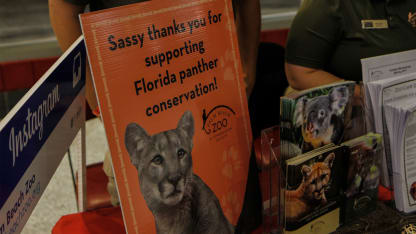"It's incredibly generous for the Florida Panthers organization to be supporting panther conservation and wildlife conservation in general," Palm Beach Zoo President & CEO Andrew Aiken said. "For zoos, our mission is to inspire people every day to act on behalf of wildlife. The way we do that at the zoo is by actually getting people up and very close to our animals.
"We have two Florida Panthers on exhibit. One is a rescue that we just got as a kitten. The other we got two years ago from the National Panther Refuge after an automobile killed its mother. There are natural development pressures put on the panthers that we do have in the wild. It's our responsibility to share what's going on with the people that visit the zoo and let them know how they can make a difference for the animals out there in the wild."
The Florida Panther -- the state's official animal since 1987 - is currently one of the most endangered mammals in the world, with an estimated 180 to 200 living in the wild as of 2017.
As their natural habitat continues to be encroached upon, motorists, particularly those driving through what Aiken calls "Panther Country" -- State Road 29 and Alligator Alley (I-75) -- have begun to encounter these animals at an alarming rate, leading to a staggering 36 vehicle-related panther deaths last year alone.
"That's the greatest threat to the Florida Panther right now," Aiken said.
The Florida Panther is an umbrella species, meaning they protect many other plants and animals that live in the area. At the top of the food chain, panthers not only keep feral hog numbers in check, but also make sure that deer, raccoon and other prey populations remain balanced and healthy.
"The Panther population is expanding and it has to expand," Aiken said. "When it expands in a contained space, every one of those animals needs about 60 square miles to live its natural life. We have a few on exhibit, but in the wild is where we need to take care of them."
At Zoo Miami, Dr. Frank Ridgley, like Aiken, believes that education is the key to protecting the local panther population both now and in the future, with a rescue panther named Mahala, who highlights the "Mission Everglades" exhibit, serving as the zoo's top teaching tool.
"We want to build future conservation stewards," said Dr. Ridgley, who serves as Zoo Miami's Director of Conservation and Research. "It's a huge chunk of our mission. Not only are we participating in global efforts to save endangered species, we're also out there in the field and on the ground.
"If we can reach out to those future generations that are going to be in charge someday and educate them on how important these things are, we can get them to have a real connection to animals. We've found that once they've made that connection, it usually lasts for life."
If you would like to know more about how to help the Florida Panther, please visit either
Zoo Miami
or the
Palm Beach Zoo
to learn more about each of their local conservation efforts.



















